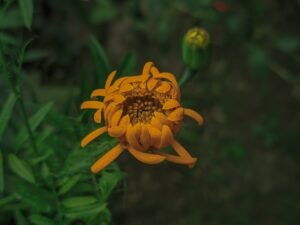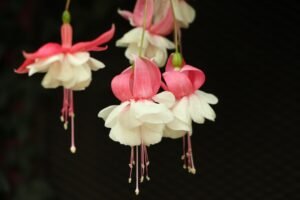Chrysanthemums, also known as mums, are beautiful flowers that have been cultivated for centuries and hold great significance in various cultures around the world. These flowers are native to Asia, particularly China, and have since spread to other parts of the world. Chrysanthemums come in a wide range of colors and varieties, each with its own unique meaning and symbolism. They are not only admired for their beauty but also valued for their medicinal properties. In this article, we will explore the history, symbolism, cultivation, cultural significance, and various uses of chrysanthemums.
Key Takeaways
- Chrysanthemums have a rich history and symbolism, representing longevity, loyalty, and joy.
- There are many varieties of chrysanthemums, each with their own meanings, such as red for love and white for purity.
- Growing and caring for chrysanthemums requires proper soil, watering, and pruning techniques.
- Chrysanthemums hold cultural significance in Japan and China, where they are celebrated in festivals and used in traditional medicine.
- Chrysanthemums are used in art, literature, weddings, and funerals, symbolizing love, remembrance, and celebration.
The History and Symbolism of the Chrysanthemum
The chrysanthemum has a long history that dates back thousands of years. It is believed to have originated in China around the 15th century BC and was later introduced to Japan in the 8th century AD. From there, it spread to other parts of Asia and eventually to Europe and the Americas.
In Chinese culture, the chrysanthemum is highly revered and is often referred to as the “flower of autumn.” It is associated with longevity, nobility, and power. The flower is often depicted in Chinese art and literature as a symbol of beauty and perfection. In Japan, the chrysanthemum is considered the national flower and is a symbol of the emperor and the imperial family. It represents longevity, rejuvenation, and purity.
The Different Varieties of Chrysanthemums and Their Meanings
Chrysanthemums come in a wide variety of colors and forms, each with its own unique characteristics and meanings. Some popular varieties include the pompon, spider, daisy, cushion, anemone, and decorative types.
The pompon chrysanthemum has small, rounded flowers that resemble pom-poms. It symbolizes cheerfulness and joy. The spider chrysanthemum has long, thin petals that resemble spider legs. It represents creativity and uniqueness. The daisy chrysanthemum has a simple, daisy-like appearance and symbolizes innocence and purity. The cushion chrysanthemum has large, rounded flowers that resemble cushions. It represents comfort and relaxation. The anemone chrysanthemum has a unique, fringed appearance and symbolizes anticipation and excitement. The decorative chrysanthemum has large, showy flowers and represents elegance and beauty.
How to Grow and Care for Chrysanthemums
| Topic | Information |
|---|---|
| Planting | Chrysanthemums should be planted in well-draining soil with full sun exposure. They can be planted in the spring or fall. |
| Watering | Chrysanthemums require regular watering, but be careful not to overwater as this can lead to root rot. Water at the base of the plant to avoid getting the leaves wet. |
| Fertilizing | Chrysanthemums benefit from regular fertilization with a balanced fertilizer. Fertilize every 2-3 weeks during the growing season. |
| Pruning | Chrysanthemums should be pruned regularly to encourage bushy growth and prevent legginess. Pinch back the tips of the stems when they reach 6 inches in height. |
| Pests and Diseases | Chrysanthemums can be susceptible to aphids, spider mites, and powdery mildew. Use insecticidal soap and fungicides as needed. |
| Winter Care | Chrysanthemums are hardy perennials in some regions, but in colder climates they may need to be protected from frost. Mulch around the base of the plant to insulate the roots. |
Chrysanthemums are relatively easy to grow and care for, but they do require specific conditions to thrive. They prefer well-drained soil and full sun exposure. It is best to plant them in the spring or early summer to allow them enough time to establish their roots before winter.
When planting chrysanthemums, make sure to space them at least 18 inches apart to allow for proper air circulation. Water them regularly, but be careful not to overwater as this can lead to root rot. Fertilize them every two weeks during the growing season with a balanced fertilizer.
Chrysanthemums are susceptible to various pests and diseases, including aphids, spider mites, powdery mildew, and leaf spot. To prevent these issues, regularly inspect your plants for any signs of infestation or disease and take appropriate measures to control them. This may include using insecticidal soap or fungicides.
The Cultural Significance of Chrysanthemums in Japan and China
In both Japan and China, chrysanthemums hold great cultural significance and are deeply ingrained in the traditions and customs of these countries.
In Japan, the chrysanthemum is considered the national flower and is a symbol of the emperor and the imperial family. It is often used in the design of the imperial crest and is associated with the highest levels of honor and respect. The chrysanthemum is also a popular motif in Japanese art, particularly in paintings and ceramics. It is often depicted in traditional Japanese gardens, where it is carefully cultivated and arranged to create stunning displays.
In China, the chrysanthemum is highly revered and is often referred to as the “flower of autumn.” It is associated with longevity, nobility, and power. The flower is often depicted in Chinese art and literature as a symbol of beauty and perfection. Chrysanthemums are also commonly used in traditional Chinese medicine for their medicinal properties.
Chrysanthemum Festivals Around the World

Chrysanthemum festivals are held in various parts of the world to celebrate the beauty and cultural significance of these flowers. These festivals often feature elaborate displays of chrysanthemums, as well as traditional music, dance, and food.
One of the most famous chrysanthemum festivals is held in China during the autumn season. This festival showcases a wide variety of chrysanthemums in different colors and forms. The flowers are carefully arranged to create stunning displays and are often shaped into intricate designs, such as dragons or pagodas.
In Japan, the city of Nihonmatsu holds an annual chrysanthemum festival known as the “Nihonmatsu Chrysanthemum Doll Festival.” During this festival, thousands of chrysanthemums are arranged to create life-sized dolls that represent historical figures or characters from folklore.
The Use of Chrysanthemums in Traditional Medicine
Chrysanthemums have been used in traditional medicine for centuries due to their various medicinal properties. They are believed to have anti-inflammatory, antibacterial, and antioxidant effects.
In traditional Chinese medicine, chrysanthemums are often used to treat various ailments, including headaches, fever, high blood pressure, and respiratory infections. They are also believed to have a calming effect on the mind and can be used to relieve stress and anxiety.
Chrysanthemum tea is a popular herbal remedy made from the flowers of the chrysanthemum plant. It is often consumed for its soothing and cooling properties and is believed to promote overall health and well-being.
Chrysanthemums in Art and Literature
Chrysanthemums have long been a popular subject in art and literature, particularly in Asian cultures. They are often depicted in paintings, ceramics, and poetry as symbols of beauty, elegance, and perfection.
In Chinese art, chrysanthemums are often portrayed in traditional ink paintings. These paintings typically feature delicate brushstrokes and subtle shading to capture the intricate details of the flowers. Chrysanthemums are also commonly depicted in Japanese art, particularly in ukiyo-e prints. These prints often feature vibrant colors and bold compositions to create striking images of chrysanthemums.
In literature, chrysanthemums are often used as symbols of beauty, purity, and resilience. They are frequently mentioned in poems and haikus as a representation of the changing seasons and the fleeting nature of life.
Chrysanthemums in Wedding Bouquets and Decorations
Chrysanthemums are a popular choice for wedding bouquets and decorations due to their beauty and symbolism. They are often used to create stunning floral arrangements that add a touch of elegance and sophistication to any wedding.
In wedding bouquets, chrysanthemums can be combined with other flowers such as roses, lilies, or orchids to create a beautiful contrast of colors and textures. They can also be used on their own to create a simple yet elegant bouquet.
In wedding decorations, chrysanthemums can be used to create stunning centerpieces, aisle decorations, and floral arches. They can be arranged in various ways, such as in tall vases or cascading arrangements, to create a dramatic effect.
Chrysanthemums as a Symbol of Remembrance in Funeral Ceremonies
Chrysanthemums are often used as a symbol of remembrance in funeral ceremonies in many cultures. They are associated with death and mourning and are often used to pay tribute to the deceased.
In China, chrysanthemums are commonly used in funeral ceremonies to honor the deceased and express condolences to the grieving family. They are often placed on the altar or grave as a symbol of respect and remembrance.
In Japan, white chrysanthemums are often used in funeral ceremonies to symbolize grief and mourning. They are also used to create floral arrangements that are placed on the altar or grave.
Celebrating November Birthdays with Chrysanthemum-Themed Gifts and Decorations
Chrysanthemums are the birth flower for the month of November, making them a perfect choice for birthday gifts and decorations during this time.
For November birthdays, chrysanthemum-themed gifts can include floral arrangements, potted chrysanthemum plants, or chrysanthemum-inspired jewelry. These gifts not only celebrate the recipient’s birthday but also honor the significance of chrysanthemums as the birth flower for November.
In terms of decorations, chrysanthemums can be incorporated into table centerpieces, wreaths, or garlands to create a festive atmosphere for November birthday celebrations. They can also be used to decorate birthday cakes or cupcakes for an added touch of elegance.
Chrysanthemums are beautiful flowers that hold great significance in different cultures around the world. They have a rich history and symbolism that is deeply ingrained in the traditions and customs of these cultures. From their origins in China to their spread to other parts of the world, chrysanthemums have captivated people with their beauty and meaning.
Whether it is their various colors and varieties, their use in traditional medicine, their role in art and literature, or their significance in weddings and funerals, chrysanthemums continue to be cherished and admired by people from all walks of life. So the next time you come across a chrysanthemum, take a moment to appreciate its beauty and the rich cultural heritage it represents.
If you’re fascinated by the symbolism and meaning behind birth flowers, you’ll definitely want to check out this captivating article on the November birth flower. Delve into the enchanting world of chrysanthemums and discover why they hold such significance for those born in November. From their vibrant colors to their rich cultural history, chrysanthemums are truly a sight to behold. To further explore the wonders of this beautiful bloom, be sure to read this insightful article: https://justtidings.com/the-changing-landscape-icc-navigates-new-frontiers-in-crickets-evolving-world/.




















+ There are no comments
Add yours